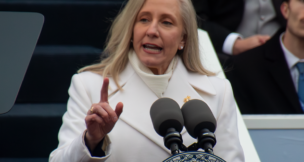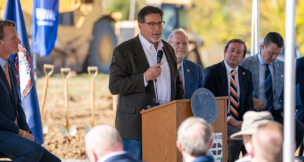The rate stuff
Sentara rate probe: Inflated premiums or federal overreach?

Sentara Health, which operates Sentara Martha Jefferson Hospital in Albemarle County, is at the center of a federal civil investigation over how the Hampton Roads-based health care system’s former Optima Health subsidiary set insurance rates in Charlottesville for the Affordable Care Act market in 2018 and 2019. Photo courtesy Sentara Health

Sentara Health, which operates Sentara Martha Jefferson Hospital in Albemarle County, is at the center of a federal civil investigation over how the Hampton Roads-based health care system’s former Optima Health subsidiary set insurance rates in Charlottesville for the Affordable Care Act market in 2018 and 2019. Photo courtesy Sentara Health
The rate stuff
Sentara rate probe: Inflated premiums or federal overreach?
Three Charlottesville residents allege Sentara inflated local insurance rates to maximize profits.
The health system says it’s being unfairly targeted and was just being a good corporate citizen, stepping up to prevent vulnerable Virginians from losing health care coverage.
After three years, a federal civil investigation has yet to determine who’s right.
On Nov. 1, 2017, Charlottesville resident Ian Dixon was among millions of people nationwide who logged on to HealthCare.gov to find out how much it would cost to insure his family for the following year.
A self-employed creator of traffic apps for the cities of Boston and Los Angeles, Dixon had been paying about $1,000 a month to cover his family of four since the Patient Protection and Affordable Care Act was implemented in 2014. Aware of the Trump administration’s intent to repeal the ACA and the fact that his income disqualified him from ACA tax credit subsidies, Dixon expected his premiums to rise by perhaps 10% or 15%.
Instead, Dixon learned his premiums for 2018 were going to shoot up to more than $3,000 per month — a 300% increase. Optima Health (now part of Sentara Health Plans), a subsidiary of Hampton Roads health care system Sentara Health, was the only insurer then offering ACA plans in the Charlottesville area.
“I remember just being enraged and running out of my home office and into the living room and turning the TV on because I thought, ‘This is massive news. This is probably all over the country. This is surely on CNN or whatever.’ And there was just no news about it,” he says. “It took us several days to figure out this is just Virginia, and especially Charlottesville.”
Within weeks, Dixon created a Facebook group, Charlottesville for Reasonable Health Insurance (CRHI), to connect with other people grappling with the same predicament. The group swelled to 700 members and Dixon soon joined forces with two of the impacted Charlottesville residents who’d joined the group, Karl Quist, a fellow small business owner, and Sara Stovall, who worked for a small business that didn’t offer health insurance. Together, the trio commenced what they saw as a David-and-Goliath-style battle against Sentara, one of Virginia’s largest health care providers.
Founded in 1888 as a small medical facility that evolved into Sentara Norfolk General Hospital, Sentara Health now has 30,000 employees and operates 300 health care facilities statewide, including 11 hospitals. As part of a 2023 systemwide rebranding, it retired and combined its Optima Health and Virginia Premier insurance brands to create Sentara Health Plans, which provides health insurance coverage to more than 1 million customers in Virginia and Florida.
In their quest to understand how and why Optima’s 2018 premiums had increased so sharply, Dixon, Quist and Stovall pored over the dense mathematical calculations and federal and state policies that control insurance rates. They gave interviews to The New York Times and The Washington Post and met with Sentara and Optima executives, state regulators, elected officials and the IRS.
“We just figured we had to get this in front of the right person,” says Stovall.
Subsequently, in 2021, the U.S. Department of Justice launched a civil federal False Claims Act investigation into how Sentara set its 2018 and 2019 premiums.
The investigation was made public in November 2023, when the Justice Department filed a petition in U.S. District Court in Charlottesville, alleging Sentara withheld relevant documents from government investigators. The DOJ asked the court to order additional testimony from executives, including former Sentara CEO Howard Kern, former Optima CEO Michael Dudley and Optima Chief Actuary James Juillerat, who still works for Sentara, as the government worked to determine whether the company deliberately misled state regulators as it collected more than $650 million in federal subsidies statewide during the two years in question.
While such investigations may lead to a formal civil action or ultimately be dropped without further action, the DOJ has not announced any conclusion to the probe, and Sentara is fighting back against what it categorizes in court filings as government overreach and a “misunderstanding of the ACA’s framework.”
In court filings and public statements, the health care system denies all allegations and portrays itself as a good corporate citizen that stepped up during a politically volatile time to prevent vulnerable Virginians from losing health insurance coverage. Sentara cites multiple vettings by the Virginia Bureau of Insurance and an independent actuarial firm and says it has fully cooperated with an investigation that has now spanned three years.
Sentara’s court filing also accuses the government of misusing the False Claims Act to “either bully Sentara into a settlement or to harm Sentara’s public reputation.”
Despite Sentara’s explanations and a corroborating letter from the Virginia Bureau of Insurance, Dixon, Quist and Stovall remain convinced that Sentara and its executives haven’t been forthright.
“No other actuary facing the same market conditions that these guys faced came up with rates close to what Optima did,” Quist says, citing data from the Centers for Medicare & Medicaid Services.
Market chaos
Even after an iconic thumbs-down vote from the late Sen. John McCain blocked an attempted July 2017 ACA repeal, the law faced intense political opposition. Overturning the ACA — commonly known as Obamacare because it was a signature achievement of President Barack Obama — was a top priority during the first two years of Donald Trump’s presidency, and insurance companies were nervous about what that might mean for them.
“The biggest issues were that there were protections — guardrails if you will — that were put into the ACA to protect the insurance companies from excess risk,” says University of Virginia School of Law professor Margaret Riley, who co-taught a course on the history of the ACA this past spring. “The Trump administration was taking those guardrails down.”
One of those guardrails was the individual mandate and another was the federal reimbursements the government had been paying to insurance companies to mitigate the risk of expanding coverage. Despite that federal support, large health insurance companies had been hemorrhaging money as they tried to figure out how to price premiums for a new and unknown pool of customers in the ACA market, including small business owners and others who weren’t able to secure affordable insurance through other means.
Medicaid expansion wouldn’t be implemented in Virginia until 2019, and Trump was threatening to end those reimbursements through executive action.
“A lot of insurance companies decided that was more risk than they were willing to take,” Riley said. “That’s why you see Aetna pulling out.”
In 2017, Aetna announced its intention to exit the Obamacare individual health insurance market in Virginia and three other states in 2018, citing $700 million in cumulative losses since ACA insurance exchanges opened in 2014. Aetna pulled out of Obamacare entirely in 2018, projecting that its continued participation could lead to a $200 million annual loss.
Also in 2017, citing similar financial concerns and market volatility, Anthem Healthkeepers said it, too, would pull out of Virginia’s ACA market for 2018.
So, for a brief time in 2017, it appeared that some 350,000 Virginians across 48 counties and 15 cities might have no access to ACA-compliant health insurance the following year. Faced with a looming health care disaster, regulators and elected federal and state officials, including then-Virginia Gov. Terry McAuliffe, pleaded with Sentara to step in to offer ACA-compliant plans through Optima in areas of the state that were at risk of having no other health insurance options.
McAuliffe “got on the phone and said, ‘You’ve got to come back into these markets,’” recalls former state Del. David Toscano, a Democrat who represented Charlottesville and part of Albemarle County from 2006 to 2020. “Then, of course, there were all kinds of issues about whether [Optima’s] rates were proper, but they did come back in, and that was good because it gave folks some options.”
Sentara’s mission is, “We improve health every day,” and that, according to a statement from company spokesperson Michael Kafka, is what drove Sentara to expand its health insurance offerings in Virginia in 2018 at a substantial risk to its own bottom line.
“As the only option in some markets, Sentara assumed all the risk of insuring a larger and potentially more vulnerable population instead of sharing the risk with competitors,” Kafka says.
Sentara agreed to offer coverage in markets where it operates facilities and rushed to formulate rates, taking 26 days to do what would normally take six months or more. Those rates, according to Kafka’s statement, were certified, as required under federal law, by Seattle-based independent actuarial and consulting firm Milliman and approved twice by the Virginia Bureau of Insurance, the state body charged with regulating health insurance rates.
In September 2017, when Sentara announced it would expand availability of its Optima Health plans in Virginia, the health system said that 70% of existing customers statewide would see their premiums go up just $4 a month on average, thanks to federal subsidies. But the remaining 30% would see a more significant average increase of 81.8%.
“While this is not the outcome we had hoped, it will allow us to continue to serve 80% of our existing members and provide an option for another 70,000 Virginians who are losing their current insurance plan,” former Optima Health President Michael Dudley said in a news release at the time.
Sentara’s premiums in the Charlottesville region — a market largely served by the University of Virginia’s UVA Health system and Sentara Martha Jefferson Hospital — were by far the highest in the country, more than double the national median and 23% higher than the next highest market, according to data from the Centers for Medicare & Medicaid Services. With an average per member per month cost of $1,203 in 2018, the 7,734 members served by Optima’s individual plans in Charlottesville generated an estimated $111.6 million in annual revenue for Sentara. Approximately 90% of that was borne by the federal government’s ACA Premium Subsidies, meaning the average customer’s out-of-pocket cost was only about $120 per month, with some paying nothing and others paying more.
When Optima CEO Dudley claimed in a November 2017 Washington Post article that Optima’s high 2018 premiums were due in part to UVA Health’s high cost of care, UVA Health pushed back in a letter to the editor, citing CMS data showing prices for health care in Charlottesville were lower than average. The letter noted that with no competition in Charlottesville, Optima was free to raise rates sharply.
“There is a problem here, but it’s not Charlottesville or the UVA Health System,” wrote Richard P. Shannon, then U.Va.’s executive vice president for health affairs. A spokesperson for UVA Health System declined to comment on the matter. Shannon, now an executive with Duke University Health System, did not respond to an inquiry.
Complicated business
Determining insurance premiums has always been a complex process, and the ACA added new requirements for insurers including restricting which factors may be used in setting rates.

Quist, Dixon and Stovall say they found reason for concern about how Sentara set its rates as they dug into the data. The first sign something was wrong, they say, was in the area rate factor (ARF) the company had applied to the Charlottesville market. A measure of the cost of care in a particular area, the ARF allows insurers to apply a surcharge to premiums in places where providers charge higher than average rates for medical services. It can only be based on the prices charged by providers in that area.
When Optima first filed its Charlottesville rates in May 2017, it used an ARF of 1.26, meaning it estimated that the prices charged for health care in Charlottesville would be 26% higher than the state average in 2018, similar to the ARF of 1.22 it previously applied to the Charlottesville market for 2016. (Optima didn’t offer coverage in Charlottesville in 2017.) After Anthem pulled out of the Charlottesville market, leaving Optima as the sole provider, Optima refiled 2018 rates for Charlottesville with an ARF of 1.579, resulting in a 58% higher premium than the state average.
“If, for some reason, Charlottesville doctors just charged [58%] more for the same procedure you could get here versus somewhere else, then a [58%] surcharge would be appropriate,” Quist explains, but he contends, a closer look at the numbers revealed something wasn’t adding up.
In fall 2017, Quist and Stovall found alternatives to Optima. Quist signed up for a non-ACA catastrophic health insurance policy to cover his family in 2018. Stovall managed to get 2018 coverage through a small group plan her employer agreed to offer. Dixon says that to qualify for an Optima small group plan, he’d been forced to hire an employee he didn’t need.
In the process of sorting through their options, they noticed that Optima had applied an ARF of just 0.93 for small group plan premiums, meaning Sentara expected to pay lower than average prices for small group medical expenses in Charlottesville.
“That … was like alarm bells are going off,” Quist says, noting that individual members and small group members would be utilizing the same providers and therefore should be charged the same amount for services.
However, Sentara and others, including the state insurance bureau, have disagreed, saying that comparing small group premiums with the ACA market is not an apples-to-apples comparison.
“The risk and market conditions in 2016 were very different than in 2018 for Optima and the insurance industry as a whole,” Kafka says in a statement. “This was true for the small group and individual markets, which also have different sets of rules and risks associated with them, leading to variations in costs between the two markets. The BOI approved Optima’s rates for both years’ ARFs, conducted an additional review and reaffirmed that the rates in both markets were ‘justified.’”
In a November 2017 interview with The New York Times, Dixon and Stovall voiced their alarm over Optima’s skyrocketing insurance premiums. As a result, Sentara invited Dixon and Stovall to meet with Optima executives, including then-outgoing Optima Health CEO Dudley and incoming Optima CEO Dennis Matheis (now Sentara Health’s CEO) to discuss their concerns about Sentara’s premium rates for Charlottesville.
The pair considered turning the invitation down, assuming it was a PR move on the company’s part, “and then we got to talking and decided, ‘Well, we could bring Karl,’” laughs Stovall, who calls Quist their “secret weapon.” A 52-year-old Navy veteran who co-founded price comparison and coupon service PriceBlink, Quist says he’s studied insurance rates for years.
“I am a very analytical person, and this was also very personal to me,” says Quist. “A 20% increase on a thousand-dollar premium is $200 a month that I would rather not pay, and I certainly don’t want to pay $2,000 more in a month.”
On Dec. 13, 2017, the three Charlottesville residents met with outgoing Virginia Insurance Commissioner Jacqueline Cunningham and her successor, current Commissioner Scott White, in Richmond. They requested that the Bureau of Insurance investigate Optima’s rates, starting with the discrepancy between Optima’s ARFs for individual and small group plans in Charlottesville.
The next day, Dixon, Quist and Stovall met with Sentara execs in Charlottesville, focused on getting an explanation for how Optima had arrived at its rates.
“We knew that this area factor could not be right, that there was this discrepancy with the small group market,” says Quist. They’d also reviewed other insurers’ filings in Virginia going back years, and “none of them ever said that Charlottesville was an expensive market,” he says.
Dixon, Quist and Stovall say that Sentara execs seemed reluctant to blame UVA Health’s prices for the rates during the meeting, and instead focused on Charlottesville’s high morbidity, a measure of how sick people are within a particular area. (Sentara declined to make those executives available for comment, citing the ongoing federal investigation.) Quist claims data the three reviewed from UVA Health doesn’t support people in Charlottesville being sicker than in other places, and he points out that it wouldn’t matter even if it was true because the ACA prohibits considering morbidity as a factor in calculating premiums.
“The whole premise of the Affordable Care Act is pooling risk,” Quist says. “It’s putting all individuals into one big risk pool so that if you live in Southwestern Virginia and your community is afflicted with some toxic chemical-related illness, everyone in the state bears that cost.”
The meeting with the Optima executives ended on a confrontational note, recalls Quist: “I said, ‘Well, we know what the rules are around setting area factors, and the regulation says that you can use this and this, and you cannot use morbidity. And what you’ve described is against the law.’”
Sentara provided a statement saying, “Optima complied with all applicable state and federal requirements when creating regional rates. Therefore, this means Optima did not use morbidity in creating the rating factor for the Charlottesville rating area.”
The health system also points to an April 11, 2018, letter from Virginia Commissioner of Insurance Scott White supporting Optima’s rates as “actuarially justified.”
Optima’s ARF was driven chiefly by higher reimbursement rates paid to area hospitals and provider groups, White wrote, noting that utilization of health care services is higher in Charlottesville than in other regions. He explained that the increase in Optima’s ARF from 1.26 to 1.58 for 2018 was a justified response to the increased risk Optima took on by remaining in the market and absorbing additional enrollments.
“Specifically, the information reviewed by the Bureau shows that Optima adjusted for risk adjustment transfer payments to ensure that the impact of morbidity was removed from experience, as required by federal law,” the letter states.
White’s letter also defends the difference in Optima’s individual and small group plan ARFs, noting that Optima maintained a lower rate for small group plans to avoid disrupting a stable market.
“In contrast, the individual market already had experienced such a disruption following carrier exits from that market, which led to Optima adopting a different approach than in the small group market,” he wrote.
But over the next few months, the three Charlottesville residents spoke to multiple actuaries who told them the health cost guidelines developed by Milliman, the actuarial firm, and used by Optima did, in fact, reflect geographic differences in morbidity, a violation of the ACA. A later state Bureau of Insurance review of Optima’s rates confirmed it.
“Milliman has not demonstrated that differences in morbidity have been removed from the Milliman HealthCare Cost Guidelines (HCGs),” wrote BOI Chief Insurance Market Examiner Bob Grissom in a June 2019 Optima rate filing note. “Therefore, any actuarial certification included that indicated otherwise would be considered incorrect.”
In fact, while studying the documents, Dixon had spotted something curious about the certification of Optima’s 2018 rates signed by a Milliman actuary: a slight change in the specific certification language prescribed by the ACA.
“What it was supposed to say is the rates only reflect differences in provider prices and provider practice patterns and do not reflect differences in morbidity,” Stovall says. “They removed the word ‘only.’”
A complaint they filed against the Milliman actuary with the American Academy of Actuaries’ discipline board was dismissed, with the discipline board’s investigator suggesting the state Bureau of Insurance was responsible for all aspects of the insurance rates.
And Grissom’s 2019 BOI rate filing note defends Milliman, saying, “It doesn’t appear that the actuary signing the certification did so with the intent to mislead … as they believe that they had provided sufficient documentation demonstrating that morbidity was removed in developing the area rate factors.”
Milliman and the American Academy of Actuaries did not return messages seeking comment for this story, and White, the state insurance commissioner, declined an interview request.
In addition to their complaints to the Bureau of Insurance and the American Academy of Actuaries, Quist, Stovall and Dixon spent significant time in 2018 sharing their concerns with elected officials and representatives from the Virginia Attorney General’s office and the DOJ’s Antitrust Division. And that fall, the three saw more reason for concern in Optima’s 2019 rate filings for Virginia.
In August 2018, Optima filed its statewide rates for 2019, but after Anthem reentered the Virginia ACA market in 2019 with significantly lower rates, Optima attempted to refile with more competitive rates across the state. (Sentara did not attempt to alter the Charlottesville ARF, which, at 1.35, was 20% lower than the previous year). The BOI rejected Optima’s post-deadline refiling, and the State Corporation Commission upheld that decision.
“The decision not to submit its most competitive rates by the Aug. 10 filing date was Optima’s, and Optima’s alone,” reads the SCC ruling. “Only after seeing a more competitive (and timely submitted) rate filing did Optima attempt to submit lower or more competitive rates after
the filing date.” (An SCC spokesperson declined comment, instead referring a reporter to public filings on the SCC website.)
In a court document, Sentara acknowledges the premiums for 2018 ended up higher than necessary in part because some of the changes the company feared at the federal level failed to materialize.
“[Sentara] found its conservative actuarial assumptions resulted in unexpected and excess profits,” the court filing explains. That document also notes that Optima returned $99 million to its policyholders in 2019 to comply with the ACA, which requires that insurers spend 80% of premiums on actual medical care over a three-year period.
In the court filing, Sentara acknowledges that $92 million of that $99 million in rebates were covered by a risk adjustment payment from CMS that Sentara was legally required to accept. During the December 2023 hearing on the petition, according to a transcript of the hearing, a Sentara attorney said the government was questioning that risk adjustment payment. Stovall, Quist and Dixon see it as further evidence of Sentara inflating area insurance rates during 2018 and 2019.
“The government is alleging Optima inflated projected claims, which inflated premiums they were approved for, which, in turn, inflated the subsidies they received,” says Dixon.
What’s next?
In court filings, Sentara has successfully fought to keep many details of the “underlying matter” of the investigation under seal. The underlying matter in any False Claims Act investigation is a whistleblower complaint, explains Tim Heaphy, former U.S. attorney for the Western District of Virginia, the federal court district where the investigation into Sentara is taking place. Heaphy, who is not involved in the Sentara case, says the Western District has a reputation for success under the False Claims Act, including winning a $1.6 billion settlement against Illinois-based pharmaceutical giant Abbott in 2012.
False Claims Act complaints are usually — but not always — brought by former employees, Heaphy says, but “it could be a competitor. It could be people that have done some of their own investigation and research, like ratepayers or health insurance customers.”
Now a partner with Washington, D.C.-based law firm Willkie Farr & Gallagher, Heaphy says if the current U.S. attorney ultimately decides not to intervene at the end of the investigation, the underlying complaint against Sentara will be unsealed and the whistleblower could proceed independently with a civil action. Current U.S. Attorney for the Western District Chris Kavanaugh declines to comment, and the Charlottesville trio won’t reveal whether they are the whistleblowers who filed the underlying complaint. (“If we did, we wouldn’t be able to say,” says Stovall.)
In a statement, Sentara says it has turned over to the DOJ 27,000 documents and provided more than 70 hours of testimony. The company maintains it has fully cooperated with an investigation that it says was flawed from the start.

In a court filing, the health system accuses the government of using a “novel theory of liability under the ACA” to initiate its False Claims Act investigation and says federal investigators have refused to answer Sentara’s questions about the legal basis for the investigation even as the DOJ sought additional testimony from Sentara executives.
A July 2023 letter from a Sentara attorney to the DOJ explains that the company voluntarily and immediately turned over additional documents that Sentara discovered had been overlooked during its initial massive legal review. “Thus,” the attorney writes, “we reject as absurd any argument that the Department’s investigation has been thwarted or frustrated in any way.”
Despite the company’s assertions, in March, nine months after that letter was sent, the court ordered two Sentara executives to provide additional testimony. There have been no additional details about the investigation publicly released since that time.
Sentara spokesperson Kafka reasserts that the company has done nothing wrong. “As it has for more than three years,” he says in a statement, “Sentara will continue to operate in good faith and looks forward to a resolution of this matter.”
Furthermore, he says, “The last thing Sentara wanted was to be the only insurer in the market because that meant shouldering 100% of the risk for covering the community. Sentara’s rates were adjusted to reflect this reality and were reviewed by outside actuarial experts and approved twice by the Virginia Bureau of Insurance.”

















